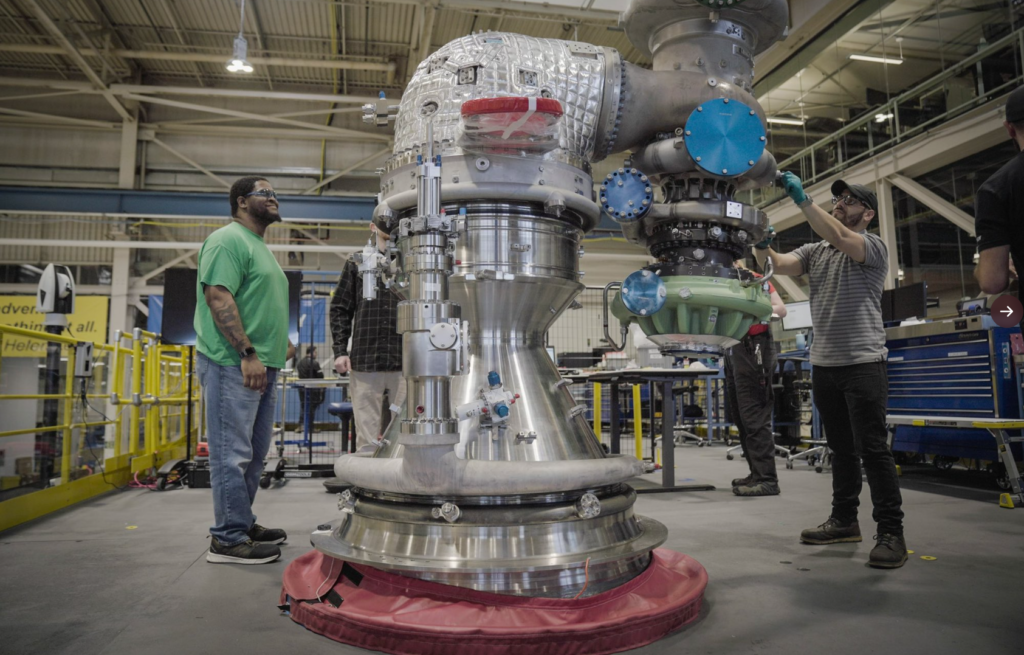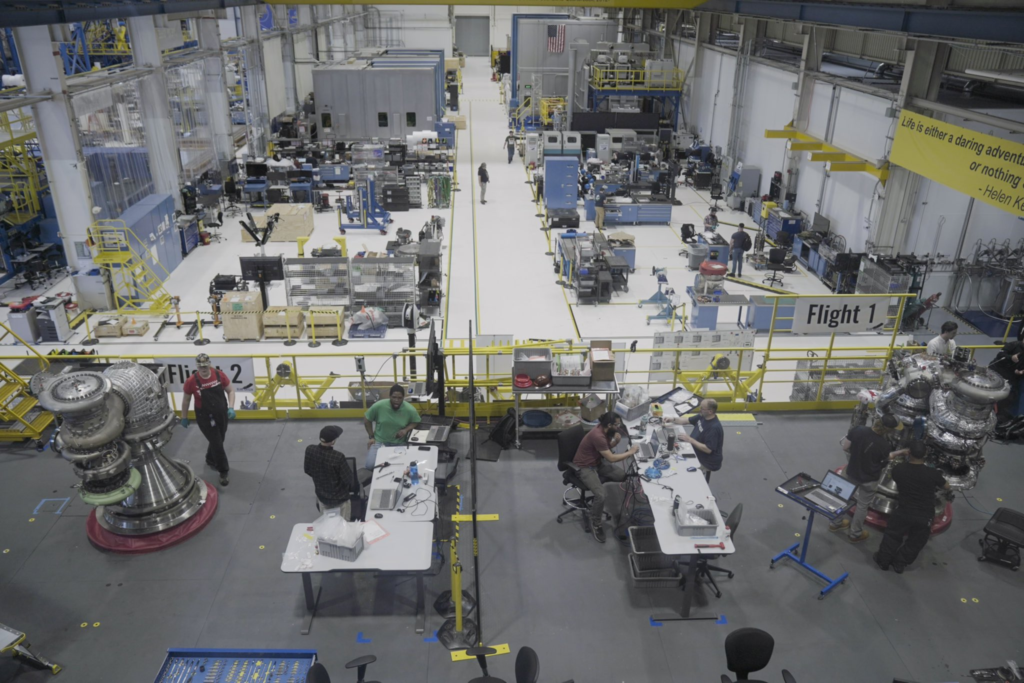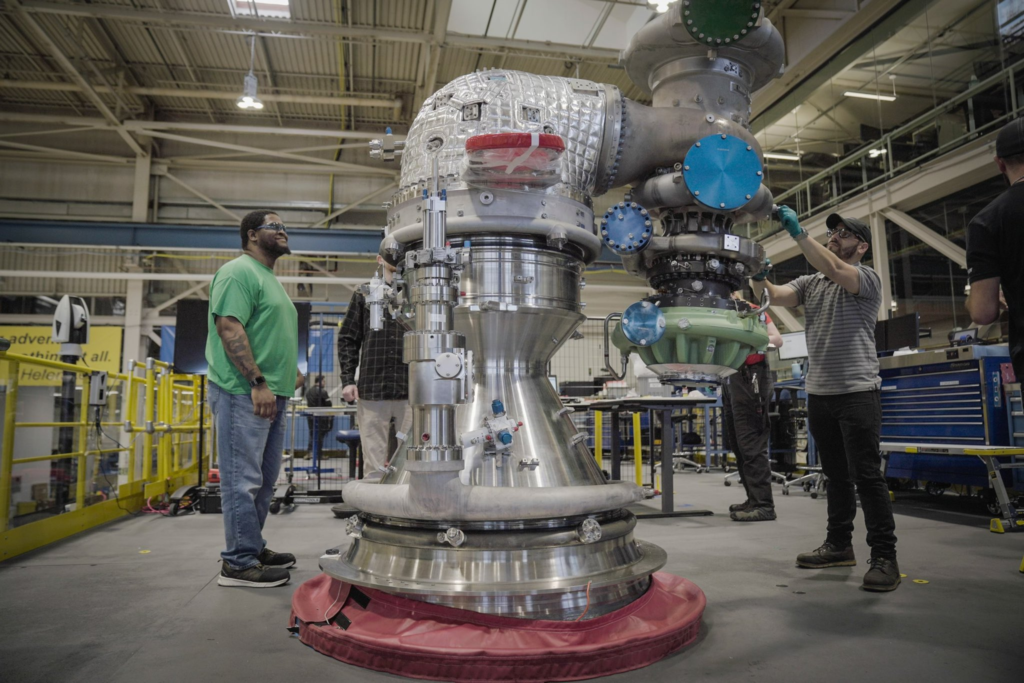
Blue Origin Continues To Work On The Development & Production of BE-4
Rocket engines are both extremely complex and important components of any rocket. This especially is the case for next-generation launch vehicles expected to work consistently with high thrust and the ability to be used again and again after each launch. For years now Blue Origin has been working to develop and now produce an engine meant to power multiple launch vehicles of the future.
BE-4 is a liquified natural gas fueled oxygen-rich staged combustion cycle engine meant to produce around 550,000 pounds of thrust. Over the past few years, the company has run into a few problems with the engine in the form of delays and other complications. This being said, now in the middle of 2022, we are starting to see more evidence of solid progress and finished engines.
Both Blue Origin and ULA are relying on the success of the engine development as they are going to be used on both New Glenn and Vulcan. Over the past few weeks, Blue Origin and ULA’s CEO Tory Bruno have provided some updates on the engines and the progress the company has made. Here I will go more in-depth into some of the recent updates, and what to expect in the coming months.
Recent Updates

When it comes to different updates on BE-4 or New Glenn for example, Blue Origin usually keeps a lot of information to themselves. Thankfully, Tory Bruno is involved because of Vulcan, and has kept us updated over the past few weeks regarding BE-4. It began earlier this month on July 2nd when Tory Bruno tweeted asking, “Hmm…. Response seems mixed. Let’s do a poll. Should I share a pic or 2 of #Vulcan‘s BE4 flight engines in fab at @blueorigin ‘s factory?” Later that same day he tweeted again this time saying, “Ok. Based on the survey results (and assuming the 5% who voted that “space is boring” just had hotdog fingers), here is a pic of BE4 flight 1. Standard Brian is busy in Decatur building the booster, so this fine @blueorigin gentleman kindly stood in for scale.” The tweet included a close up image of a full BE-4 engine with a person standing next to it for scale. In addition to the original tweet, Tory answered a few questions in the replies that gave even more information on the engine. Someone first asked why it was off center, Tory replied mentioning, “I assume you mean the turbo pumps. It’s a light weight single shaft design, mounted on the side, which also gives great packaging for the pair that goes under Vulcan.” He replied one more time pointing out, “Yup. And that’s just from the combustion chamber up. The bell is below the platform (and out of sight) for easy access for @blueorigin‘s skilled technicians to assemble this part of the engine.”
Throughout the day, Tory continued to provide more info on the engines. He later tweeted again mentioning, “Ok, since you asked, here’s a close up of the @blueorigin Flight 1 #BE4. This included two different images of the same BE-4 but a bit closer and highlighted different angles of the engine. Tory didn’t slow down with the updates as the next day on July 3rd, he tweeted again pointing out, “Ask and you shall receive. The second of the pair of @blueorigin flight #BE4 engines.” This tweet included two images of an additional pair of BlueOrigin engines in the company’s Kent factory. Someone soon asked about the nozzles and if they were not able to support the weight of the engine. Tory replied saying, “The nozzles are attached. The engine is too tall for a technician to reach the top to attach the turbo pump assembly, so there’s a giant platform for them to stand on with the rest of the engine below.” Later on July 3rd, Tory continued to provide updates with another tweet highlighting, “You guys have clearly revealed yourselves to be passionate about space. So, here’s a bonus picture just because you’re awesome: two #BE’s at once in @blueorigin ‘s Kent Factory.” This included an image of the factory and both of the engines being worked on. These two engines you see will be used on the first flight of Vulcan assuming everything goes according to plan.
BE-4, Blue Origin, & ULA

Now that we know some of the progress being made on BE-4, we can take a closer look at the engine itself and some of the companies that are relying on its success. Blue Origin describes BE-4 as America’s next rocket engine. They also point out that BE-4 is one of the most powerful liquefied natural gas (LNG) fueled rocket engines ever developed. Using an oxygen-rich staged combustion cycle, BE-4 is capable of producing 2,400 kN, or (550,000 lbf) thrust with deep throttle capability. In the past, there have been a few issues with the engine during the development and testing phase. In 2021 for example, delays had been accruing in the program for multiple years, including turbopump problems, combustion instability, overheating, and shorter-than-planned engine life. In addition, company management issues had left insufficient hardware to build development engines, leading to extended periods where no testing could be done. Now in the middle of 2022, the company is working hard to ensure the engines are working well and produced in a timely manner. Blue Origin highlights that they chose LNG because it is highly efficient, low cost, and widely available. Unlike kerosene, LNG can be used to self-pressurize its tank. Known as autogenous repressurization, this eliminates the need for costly and complex systems that draw on Earth’s scarce helium reserves. LNG also possesses clean combustion characteristics even at low throttle, simplifying engine reuse compared to kerosene fuels. BE-4 was designed from the beginning to be a medium-performing version of a high-performance architecture. It’s a conscious design choice made to lower development risk while meeting performance, schedule, and reusability requirements. With this hardware-rich approach, multiple developmental units and redundant test stands enable a high test tempo and rapid learning. Currently, BE-4 is undergoing full-scale engine development testing at Blue Origin’s facilities in Van Horn, Texas. Full rate production will occur in their new engine manufacturing facility in Huntsville, Alabama. As we saw from the tweets there is also a lot of work going on in the Kent factory.
The main reason this engine is so important is the two companies that rely on it. More specifically, two next generation launch vehicles, New Glenn and Vulcan, both use the engine. New Glenn is a single configuration heavy-lift launch vehicle with the goal of carrying people and payloads routinely to Earth orbit and beyond. Featuring a reusable first stage built for 25 missions. This reusable first stage has a lot to do with BE-4 and its design. A big part of the BE-4 engine is its ability to be used again and again. With New Glenn working towards consistent reusability, the engines need to be capable as well. Looking at the launch vehicle’s flight profile, New Glenn lifts off from Launch Complex 36 at Cape Canaveral. Following stage separation, the first stage flies back to Earth and lands nearly 1,000 km downrange on a platform. The second stage engines ignite and the 7-meter fairing separates. The mission is complete when the payload is delivered safely to orbit. With seven reusable and throttleable BE-4 LOX/LNG engines, the first stage generates 17,100 kN (3.85 million lbf) thrust at sea level. This power is meant to change how the company accesses space and the future of next generation launch vehicles. However, a lot of work still needs to be done before this rocket takes flight for the first time.
We then have United Launch Alliance and the Vulcan. Practically all the tweets I showed earlier had to do specifically with ULA and the initial engines used for Vulcan’s first flight. In terms of progress towards a first flight, ULA is a decent bit ahead of Blue Origin and we could expect a launch not long from now. The Vulcan booster propulsion is provided by a pair of BE-4 engines, manufactured by Blue Origin. Higher up on the rocket, Vulcan integrates up to six Northrop Grumman Graphite Epoxy Motor (GEM) 63XL Solid Rocket Boosters (SRBs). They are constructed out of a graphite-epoxy composite with the throttle profile designed into the propellant grain. GEM solids supported the Delta II and Delta IV rockets, and the GEM 63 variant will fly on ULA’s Atlas V rocket prior to the first Vulcan launch. At the top, Vulcan will rely on two RL10C engines to power its second stage. Logging an impressive record of nearly 400 successful flights and nearly 700 firings in space, RL10 engines, manufactured by Aerojet Rocketdyne, harness the power of high-energy liquid hydrogen. The RL10 boasts a precision control system and restart capability to accurately place payloads into orbit. All of which comes back to the current development and production of BE-4.
Conclusion
Many of us have been keeping track of Blue Origin and the company’s progress on BE-4. With two upcoming rockets relying on the engine’s success, it puts a lot of pressure on Blue Origin to ensure they complete a high quality engine in a timely manner. We will have to wait and see how it progresses and the impact it has on the space industry.
